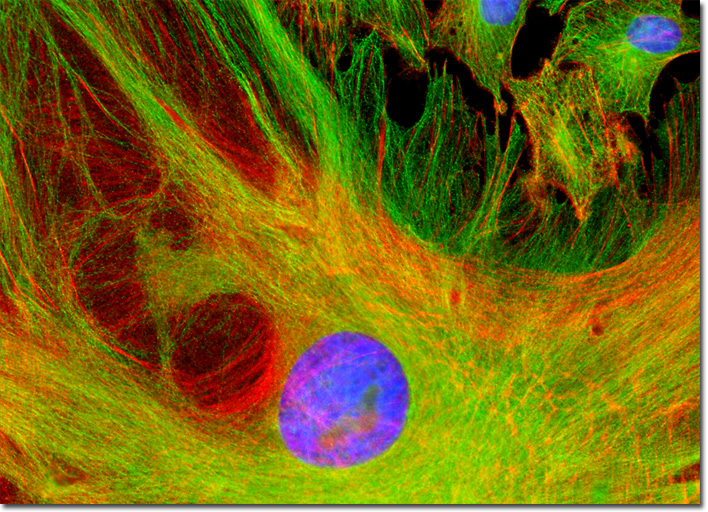Fluorescence Digital Image Gallery
Normal African Green Monkey Kidney Fibroblast Cells (CV-1)
|
The CV-1 cell line was initiated in March of 1964 by F. C. Jensen and his colleagues with a tissue section excised from the kidney of a normal adult male African green monkey (Cercopithecus aethiops). The popular fibroblast line was originally utilized in research focusing on the transformation of the cancer-causing Rous sarcoma virus (RSV), but now is a very useful host for acquired immunodeficiency disease (AIDS) research, as well as transfection experiments with simian virus 40 (SV40) and recombinant plasmid vectors. Cells of the CV-1 line exhibit the morphology of fibroblasts, grow adherently to glass or plastic surfaces, and are negative for reverse transcriptase. Widely employed as a transfection host, CV-1 cells are susceptible to several viruses, including poliovirus 1, herpes simplex, simian virus 40, California encephalitis, and both Eastern and Western equine encephalitis. The cells exhibit rapid growth and chromosome number shifts have been reported to occur at high passage levels. An adherent log phase monolayer CV-1 cell culture (illustrated above) was immunofluorescently labeled with primary anti-bovine alpha-tubulin mouse monoclonal antibodies followed by goat anti-mouse Fab fragments conjugated to fluorescein. In addition, the cells were simultaneously stained for DNA with the ultraviolet-absorbing probe DAPI, and for the cytoskeletal filamentous actin network with Alexa Fluor 568 conjugated to phalloidin. Images were recorded in grayscale with a QImaging Retiga Fast-EXi camera system coupled to an Olympus BX-51 microscope equipped with bandpass emission fluorescence filter optical blocks provided by Omega Optical. During the processing stage, individual image channels were pseudocolored with RGB values corresponding to each of the fluorophore emission spectral profiles. |
© 1995-2025 by Michael W. Davidson and The Florida State University. All Rights Reserved. No images, graphics, software, scripts, or applets may be reproduced or used in any manner without permission from the copyright holders. Use of this website means you agree to all of the Legal Terms and Conditions set forth by the owners.
This website is maintained by our
|
